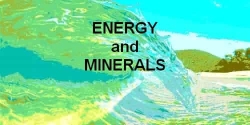Wind Towers - passive cooling - Iran
Wind Towers - passive cooling - Iran
What are wind towers?
Functions of a wind tower
The
wind tower function based on several principles
Cooling water in cisterns
Wind tower design
considerations
Wind towers in Australia?
see
also Qanats - re-directing underground water in Iran...
see
also Vertical shaft windmills in Iran...

What are wind towers?
Wind tower is a key element in traditional architecture of Iran. It is seen in settlements in hot, hot-dry and hot-humid climates. They look like big chimneys in the sky line of ancient cities of Iran. They are vertical shafts with vents on top to lead desired wind to the interior spaces and provide thermal comfort. This architectural element shows the compatibility of architectural design with natural environment. It conserves energy and functions on the basis of sustainability principles.A wind tower is an architectural device used for many centuries to create natural ventilation in buildings.

Functions of a wind tower
The function of a wind tower tower is to catch cooler breeze that prevail at a higher level above the ground and to direct it into the interior of the buildings. It is not known who first invented the wind tower, although some claim it originated in Iran and it can be seen in. wind towers come in various designs, such as the uni-directional, bi-directional, and multi-directional.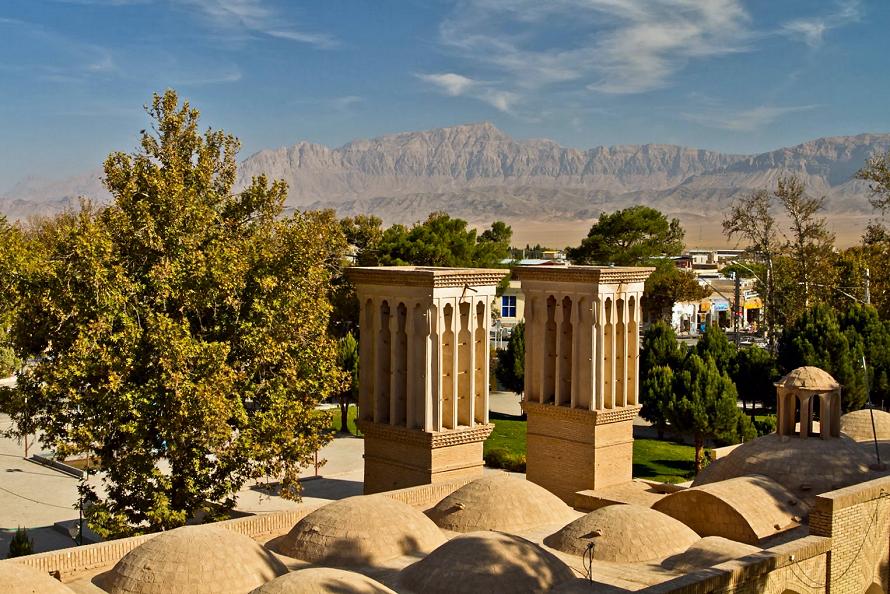
A wind tower is a formal structural element in Iranian architecture that is used to convey the wind current to the interior spaces of buildings in order to provide living comfort for occupants. In Iranian architecture a wind tower is a combi- nation of inlet and outlet openings. The tunnel provides cool air for the building while serving as a conduit through which the stuffiness within the building is conveyed through its shaft. There were wind towers in Bam which were destroyed by earthquakes; they weren't directly connected to the living hall. They were built away from the house. An additional underground tunnel links the base of the wind tower to the basement.
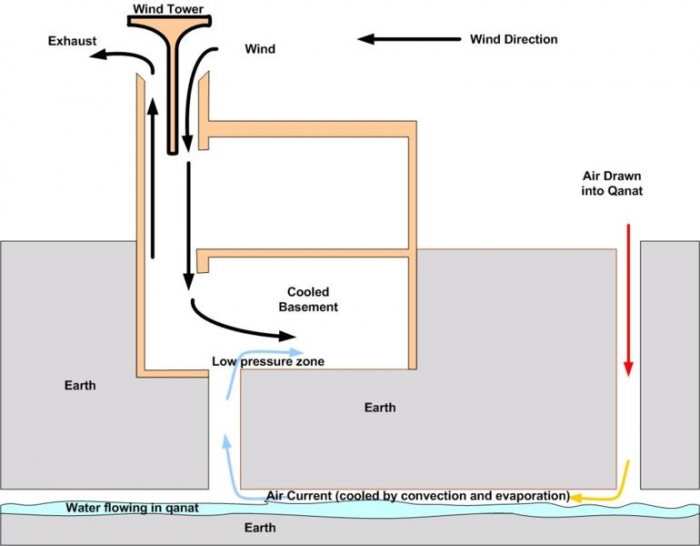
In most wind towers, especially the four sided types, the tower is divided by partitions. One of the shafts operates all the time to receive the breeze and the other three shafts work as outlet air passages. They convey the stuffiness out of the living space through the “flue” (chimney) effect. The chimney effect is based on the principle that the air density increases with the increase in temperature. The difference in temperature between the interior and exterior parts of a building and between different regions creates different pressures and result in air cur- rents. The average relative humidity in moisture in hot and dry regions is low and it is necessary more humidity there for wind towers are used to provide living comfort through the use of the air current and evaporation. Through the wind tower, the air current first passes over a stone pond and fountain after entering a building, thereby bringing humidity to the other spaces in the building
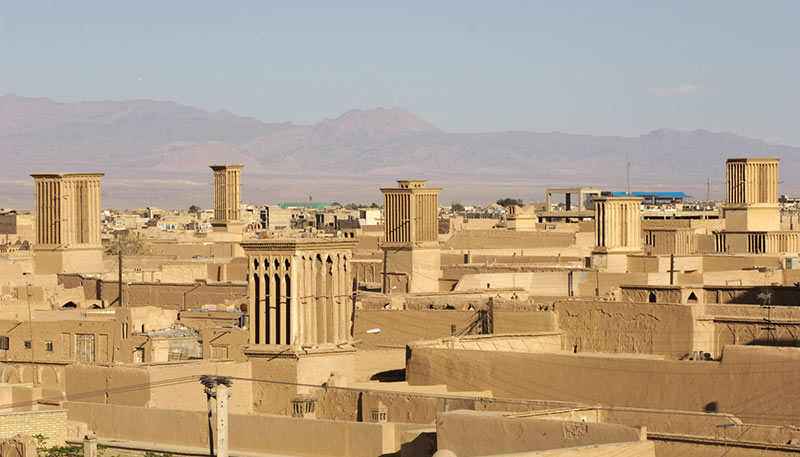
The wind tower function based on several principles:
- First, a wind tower is capped and has several directional ports at the top (traditionally four). By closing all but the one facing away from the incoming wind, air is drawn upwards using the Coanda effect, similar to how opening one facing the wind would push air down the shaft. This generates significant cooling ventilation within the structure below, but is not enough to bring the temperature below ambient alone - it would simply draw hot air in through any cracks or windows in the structure below.
- Therefore, the key to generating frigid temperatures seems to be that there are very few cracks at the base of the thick structure below, but there is a significant air gap above the qanat (a water management system used to provide a reliable supply of water to human settlements or for irrigation in hot, arid and semi-arid climates). A qanat has quite a lot of water inside, because there are frequent well-like reservoirs along its path. Completely shaded from the sun, a qanat also aggregates the cold, sinking air of the night, which is then trapped within, unable to rise up to the less dense surface air. A wind tower, however, can create a pressure gradient which sucks at least a small amount of air upwards through a house. This cool, dry night air, being pulled over a long passage of water, evaporates some of it and is cooled down further.
- Finally, in a windless environment or waterless house, a wind tower functions as a Solar or thermal chimney that uses convection of air heated by passive solar energy. It creates a pressure gradient which allows less dense hot air to travel upwards and escape out the top. This is also compounded significantly by the day-night cycle mentioned above, trapping cool air below. The temperature in such an environment can't drop below the nightly low temperature. These last two functions have gained some ground in Western architecture, and there are several commercial products using the name wind tower.
Cooling water in cisterns
When coupled with thick mud brick, the wind tower is able to chill lower-level spaces in mosques and houses in the middle of the day to cooler temperatures.So effective has been the wind tower in Persian architecture that it has also been routinely used as a refrigerating device.
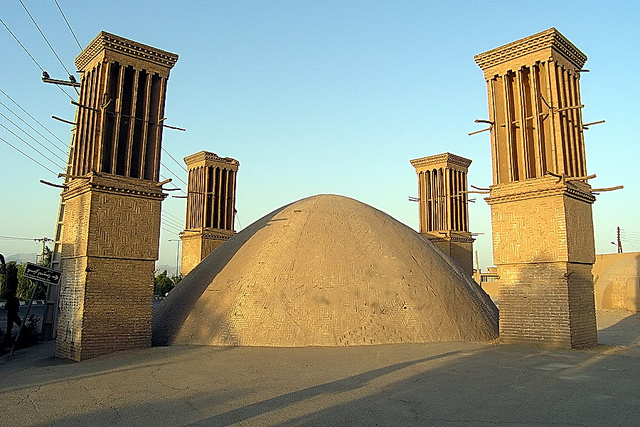
Many traditional water reservoirs, or ab anbars, are built with wind towers that are capable of storing water at near freezing temperatures for months in summer. High humidity environments destroy the evaporative cooling effect enjoyed in the dry conditions seen on the Iranian plateau; hence the ubiquitous use of these devices in drier areas such as Yazd, Kashan, Nain, and Bam.

Wind tower design considerations
Modern wind towers may incorporate the use of water near the top of the tower to enhance their effectiveness as water has a much higher heat capacity than air and this is much more efficient in removing heat air and delivering cool.Wind towers use gravity to move cool air without any fans, although fans may be used to reduce the size of the towers. The most common wind towers do this by having a wet pad medium in the top of the tower. Since cool air is heavier than warm air, it will fall, creating its own airflow. Wind while not required, greatly improves the airflow.
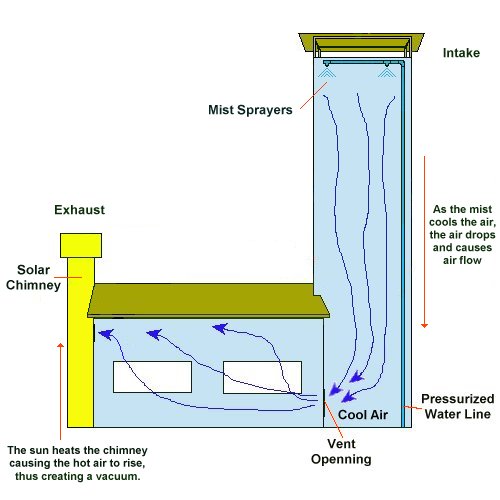
Basic modern wind tower design
Not really very effective and the tall tower means high cost.
This tower requires a very long drop and the resulting cost of a tall tower could be better spent on a more advanced design system.
The tower would have to be wider in diameter to support it's height.
This system operates only on the Buoyancy Principle described above and does not require wind to operate.
If you live in an area with no wind, then this is the tower for you.
Generally wind towers without fans are from 6 to 9 metres tall and between 2 and 3 m2. Typically wind towers of this size will perform better with the addition of a fan of 10 to 150 watts, and will cool a small house. Airflow for these wind towers will range from 70 to 225 m3 per minute
Passive ventilation systems rely on the movement of air through buildings to equalize pressure. The pressure difference can be caused by wind or the buoyancy effect created by stratified warm air. In either case, the amount of ventilation will depend critically on the size and placement of openings in the building.
Buoyancy ventilation is more commonly referred to as temperature-induced or stack ventilation. Buoyancy results from differences in air density. The density of air depends on temperature and humidity. Cool air is heavier than warm air at the same humidity. Thus, airflow is generated by the dropping of heavier air, forcing lighter air to exhaust. Tower height, or the distance from the air intake (top of tower) to the air outlet (bottom of tower), will determine the velocity or pressure of the air. The greater this distance the more air pressure created, similar to a water column. The tower uses a column of cool moist air (compared to the hot dry air outside) to create this pressure.
Wind causes a positive pressure on the windward side and a negative pressure on the leeward side of buildings. To equalize pressure, fresh air will enter any windward opening and be exhausted from any leeward opening.
Cooler pads sit at the top of a tower with a pump re-circulating water over them. As hot air passes through the pads it is cooled by the evaporation of the water. Cool moist air is heavier than hot dry air and drops down the tower and into your house. In order for the cool air to flow in, hot air must be exhausted.
Design Of Your Tower
Your tower should be a minimum of 2m X 2m. square and about 8m in height, most are about about 9m tall. Your tower should be insulated with at least an R-10 Factor, but R-19 or higher would be better.Where prevailing breezes are not dependable enough to rely on wind-induced ventilation and where keeping indoor temperature sufficiently lower than outdoor temperature to induce buoyant flow is a problem, then a solar chimney may be an effective solution. The chimney is isolated from the occupied space and can be heated as much as possible by the sun or other means. Hot air is simply exhausted out the top of the chimney creating a suction at the bottom which is used to extract indoor air.
A large solar chimney can be used to exhaust the air from your home, but a downwind swiveling exhaust scoop is a better alternative. The more exhaust scoops you have the better. These enhancements will increase the air flow; using upwind and downwind scoops that swivel to orient the wind is the best choice.
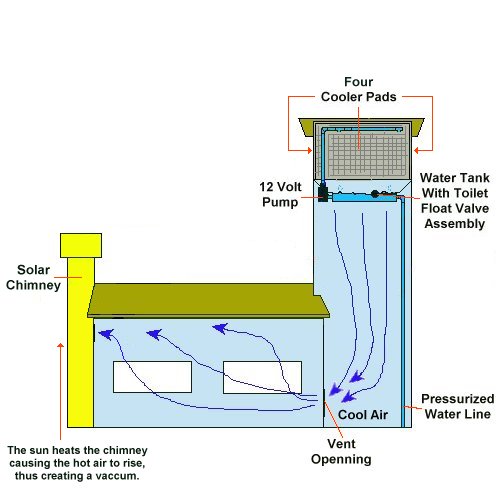
Most common modern wind tower designIf using wind, your cooler pads will be at the top or inside of the tower, depending on the design. Just below the cooler pads you should have a tank containing 55 to 110 litres of water with a float valve assembly to keep the tank full. Locate outside the tank a small 12 Volt pump. It is best to use a non submergible pump.
As wind blows through the wet pads, the water evaporates and cools the air.
Placing pads at the top of the tower usually requires appropriately 6.5 to 7.5 m2 of pads.
With evaporative coolers you must leave an exit for the air to escape from your house.
In normal water coolers a blower circulates the air, in this design wind and buoyancy will do the job for you.
Standard cooler pads will work, but there are better, more efficient pads available that have less wind resistance .
Of course these higher quality pads will cost more.
Water must flow down the pads and air must pass through them in order to have the evaporation needed to cool the air.
Vents must have a larger opening than those used with a forced air system because there is no pressurized fan blower in this system.
This tower is 2 x 2 x 9 m .
Evaporating water is what creates the cooling and makes evaporative coolers and wind towers work. Rain water is the perfect source for the water used in wind towers because it does not have dissolved salts or minerals. Well water can contain dissolved minerals. As the water evaporates from the cooler pads, whatever minerals it contains are left behind. This buildup can eventually clog the pads and block air flow

Advanced modern wind tower design
To create a larger air flow down the cool tower, install one large upwind swivel scoop above the pads in the tower.
Your air scoops should have a venturi system (tail) to keep the scoop oriented into the wind.
Instead of one large exhaust vent for the hot air, install smaller openings in the roof with down wind swivel scoops to remove the heat.
Your exhaust vents should also swivel with a venturi system to keep the exhaust openings oriented away from the wind.
With this system the wind can blow from any direction and your cool tower will continue to function.
This is a more efficient design than using a solar chimney.
The intake air scoop should be made out of light aluminum or designed with an aluminum frame with canvas stretched over it.
The canvas scoop is recommended because it is lighter and generates almost no noise.
In this design the pads are just below the scoop inside the tower with ducting to direct the air flow into and through the pads .
This reduces the size and area of the cooler pads, thus reducing the cost.
This design requires about 2m2 of 100mm. thick pads.
Cooler pads that are inside the tower and below the scoop are protected from direct sun light and last longer due to lack of UV damage caused by the sun.
The tower itself is 2m X 2m and 9m. in height.
The air scoop occupies the top 1.25m.
Two pads about 0.25m2 by 100mm thick are located just below the air scoop with this design you can also add removable doors to close off top of tower in case of a wind storm
For more on modern wind tower design download from this site...
"A new design of wind tower for passive ventilation in buildings to reduce energy consumption in windy regions A.R. Dehghani-sanij , M. Soltani , K. Raahemifar "
Wind towers in Australia?
Wind towers work best where the wind is constant and from one direction.
Wind rose Hughenden Queensland 2% calm
Hughenden Queensland is calm only 2% of the time and winds dominantly come from just one quadrant.
This makes it an ideal location for using wind towers.
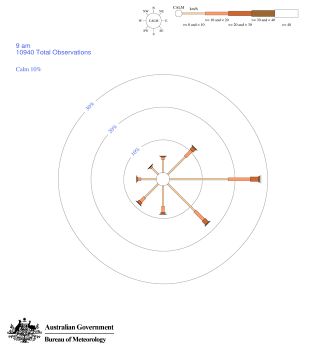
Wind rose Newman Western Australia 10% calm
Newman in Western Australia is calm for 10% of the time, the winds come from all quadrants.
This makes it less ideal for wind towers, however it still might be possible...
- if the main wind direction comes at the hottest time of year when most needed
- if the calm time is in the cool season when the tower is not needed
source: visit by Earth Science Australia
http://www.solaripedia.com/13/205/2089/wind_tower_yazd_iran.html
http://www.solaripedia.com/13/205/2085/wind_tower_convection_illustration.html
http://citeseerx.ist.psu.edu/viewdoc/download?doi=10.1.1.466.2985&rep=rep1&type=pdf
http://www.i4at.org/lib2/aircool.htm
http://www.bom.gov.au/climate/averages/wind/selection_map.shtml

